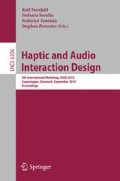Abstract
The senses of vision and touch are vital modalities used in the discrimination of objects. In this research effort, a haptic device is used to determine thresholds of curvature discrimination in visual-haptic experiments. Discrimination thresholds are found for each sense independently as well as for combinations of these with and without the presence of conflicting information. Results indicate that on average, the visual sense is about three times more sensitive than the haptic sense in discriminating curvature in virtual environments. It is also noticed that subjects seem to rely more heavily on the sense that contains the most informative cues rather than on any one particular sense, in agreement with the sensory integration model proposed by Ernst and Banks. The authors believe that the resulting thresholds may serve as relative comparisons between perceptual performance of the sensory modalities of vision and haptics in virtual environment.
Access this chapter
Tax calculation will be finalised at checkout
Purchases are for personal use only
Preview
Unable to display preview. Download preview PDF.
References
Hayward, V., Astley, O.R., Cruz-Hernandez, M., Grant, D., Robles-De-La-Torre, G.: Haptic interfaces and devices. Sensor Review 24(1), 16–29 (2004)
Craig, J.C.: Difference threshold for intensity of tactile stimuli. Percept. Psychophys. 11, 150–152 (1972)
Jones, L., Hunter, I.: A Perceptual analysis of stiffness. Experimental Brain Research 79, 150–156 (1990)
Allin, S., Matsuoka, Y., Klatsky, R.: Measuring just noticeable differences for haptic force feedback: implications for rehabilitation. In: 10th Symposium on Haptic Interfaces for Virtual Environment and Teleoperator Systems, HAPTICS 2002 (2002)
Lubin, J.: A human vision model for object picture quality measurement. In: International Broadcasting Convention, (447) (1997)
Frisoli, A., Solazzi, M., Salsedo, F., Bergamasco, M.: A fingertip haptic display for improving curvature discrimination. Presence 17(6), 550–561 (2008)
Kuchenbecker, K.J., Ferguson, D., Kutzer, M., Moses, M.: and Okamura, A.M.: The touch thimble: providing fingertip contact feedback during point-force haptic interaction. In: Symposium on Haptic interfaces for virtual environment and teleoperator systems, Reno, Nevada, pp. 239–246 (2008)
Drewing, K., Ernst, M.O.: Integration of force and position cues for shape perception through active touch. Brain Research 1078(1), 92–100 (2006)
Posner, M., Nissen, M., Klein, R.: Visual dominance: An information-processing account of its origins and significance. Psychological Review 83(2), 157–171 (1976)
van Beers, R.J., Wolpert, D.M., Haggard, P.: When feeling is more important than seeing in sensorimotor adaptation. Current Biology 12(10), 834–837 (2002)
Burns, E., Whitton, M.C., Razzaque, S., McCallus, M.R., Panter, A.T., Brooks Jr., F.P.: The hand is slower than the eye: A quantitative exploration of visual dominance over proprioception. In: IEEE Virtual Reality, pp. 3–10 (2005)
Ernst, M.O., Banks, M.S.: Humans integrate visual and haptic information in a statistically optimal fashion. Nature 415(6870), 429–433 (2002)
Stevens, J.C., Foulke, E., Patterson, M.Q.: Tactile acuity, aging, and Braille reading in long-term blindness. Experimental Psychology: Applied 2(2), 91–106 (1996)
Lee, G.S.: Low power haptic device: Ramifications on perception and device design. Ph.D. Thesis, University of Washington (2004)
Author information
Authors and Affiliations
Editor information
Editors and Affiliations
Rights and permissions
Copyright information
© 2010 Springer-Verlag Berlin Heidelberg
About this paper
Cite this paper
Yoon, W.J., Perry, J.C., Hannaford, B. (2010). Parametric Study of Virtual Curvature Recognition: Discrimination Thresholds for Haptic and Visual Sensory Information. In: Nordahl, R., Serafin, S., Fontana, F., Brewster, S. (eds) Haptic and Audio Interaction Design. HAID 2010. Lecture Notes in Computer Science, vol 6306. Springer, Berlin, Heidelberg. https://doi.org/10.1007/978-3-642-15841-4_4
Download citation
DOI: https://doi.org/10.1007/978-3-642-15841-4_4
Publisher Name: Springer, Berlin, Heidelberg
Print ISBN: 978-3-642-15840-7
Online ISBN: 978-3-642-15841-4
eBook Packages: Computer ScienceComputer Science (R0)

